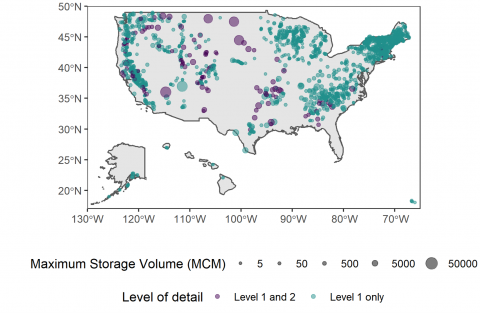
Citation
2021. Hydropower Energy Storage Capacity Dataset. Oak Ridge National Laboratory, Oak Ridge, Tennessee, USA. DOI: 10.21951/HESC/1822833
Overview
Dataset Overview
The Hydropower Energy Storage Capacity (HESC) Dataset catalogues estimates of nominal energy storage capacity based on varying levels of detail. Dams and reservoirs were selected based on those reported in the National Inventory of Dams (NID 2019) and/or the Global Reservoir and Dam (GRanD v1.3) datasets. These data provide a foundation for understanding available resources at existing hydropower facilities and their potential to provide storage of energy and more flexible generation. Current estimates include Level 1 (based on maximum storage capacities and hydraulic head) and Level 2 (based on historical models or observations of reservoir volume and hydraulic head). For facilities where installed capacity is known, there are also estimates for discharge duration or the length of time when a facility could provide generation at a given capacity. Essential information used to calculate the energy storage capacity and discharge duration (volume, hydraulic head, and details about the sources or records used to obtain those parameters) and summaries of historical generation (for context) are also included.
Data were acquired from the NID (2019), GRanD (v1.3), HydroLAKES (2016), Existing Hydropower Assets (2021), USACE via the Duke Nicholas Institue Reservoir Data efforts (Patterson and Doyle, 2018), USBR RISE, and the Hydropower reservoir data in the CONUS data set (Gao and Huilin, 2020). The HILARRI database of links was used to cross-walk between NID, GRanD, and HydroLAKES (obtaining inventoried volumes and height characteristics). Statistics were derived for historical observed and modeled volumes/head data based on the USACE, USBR, and Gao data sets. The EHA plant data were used to obtain installed capacity and operational mode information.